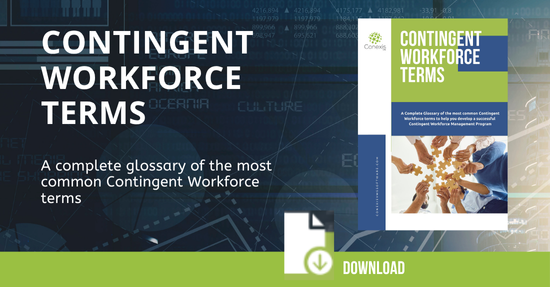Confused by contingent workforce jargon? Our quick glossary breaks down the essential terms you need to manage contingent labor programs like a pro.
Understanding the terminology used in contingent workforce management is essential for navigating the complexities of today’s flexible labor landscape. Here's a glossary of key terms you should know if you are working in contingent workforce management.
Whether you're a staffing agency, HR professional, procurement specialist, or hiring manager, having a clear grasp of key terms can help you make informed decisions, improve compliance, and optimize your contingent workforce program.
Contingent Workforce Management Definition
Contingent workforce management is the strategic process of sourcing, managing, and optimizing external workers - such as freelancers, independent contractors, temps, and consultants - who aren’t part of your full-time staff.
It covers everything from onboarding and time tracking to compliance, vendor coordination, and performance monitoring. Most companies use a Vendor Management System (VMS) to gain visibility, control costs, and improve outcomes in the management of their Contingent Workforce Program.
Key Contingent Workforce Management Terms
This glossary is designed to provide simple, straightforward definitions of the most common terms and acronyms in the contingent labor space - so you can communicate with confidence and clarity.
Download a free copy of our Contingent Workforce Terms Guide
1099 Employee
A worker classified as an independent contractor for tax purposes; they receive a 1099 form to report income on their tax return.
AI (Artificial Intelligence)
Artificial intelligence (AI) refers to the ability of computers or machines to perform tasks that typically require human intelligence, such as learning, problem-solving, and decision-making. It involves creating systems that can reason, learn, and act to solve complex problems.
Alternative Staffing
Alternative staffing is a generic term that refers to the hiring of individuals on a part-time or as-needed basis. The term refers to any worker that doesn’t fall under the regular, direct, and full-time employment. Alternative staffing arrangements typically refers to those working under short-term contracts.
Applicant Tracking System (ATS)
A software application that enables the electronic handling of recruitment needs.
Background Checks
The process of verifying that an individual is who they claim to be, which may include checking criminal records, education, employment history, and other activities from the past.
Assignment
Assignment refers to either the period of time a contingent worker is working with a business, or the task or duty that is being performed. Once the assignment is finished, their contract with an organization is up.
Bench
The group of contingent workers who are currently not on an assignment but are available for work.
Bill Rate
The rate a staffing agency charges to a client for the services of each temporary worker.
Co-Employment Risk
The risk that a client company and staffing agency become viewed as joint employers of a contingent worker, thereby sharing legal responsibilities and liabilities.
Co-Sourcing
A staffing model where a portion of the service is outsourced to an external service provider, while some strategic control remains with the internal team.
Compliance
Adherence to laws and regulations governing contingent workforce engagements, including classification of workers, tax implications, and labor laws.
Compliance Tracking
Monitoring and recording compliance with industry regulations and labor laws.
Contingent RPO (Recruitment Process Outsourcing)
A form of business process outsourcing where an employer transfers all or part of its recruitment processes to an external service provider, but only for contingent labor.
Contingent Workforce
A labor pool consisting of individuals hired by an organization on a non-permanent basis, such as freelancers, independent contractors, consultants, and temporary contract workers.
Contingent Workforce Consulting
Professional services provided by experts to help organizations develop strategies and practices for effectively managing their contingent workforce.
Contingent Workforce Outsourcing (CWO)
The practice of using an external organization to manage all or part of the processes and activities associated with the contingent workforce.
Contingent Workforce Program (CWP)
An organizational program that manages all aspects of a company's contingent labor, including staffing, procurement, and compliance.
Contingent Workforce Strategy
A business's approach to managing and optimizing the use of contingent labor.
Contract-to-Hire
A type of employment arrangement where a worker is initially hired on a temporary contract with the potential to become a permanent employee.
Cost Per Hire
The total cost associated with the recruitment of new employees, including advertising expenses, recruiter fees, and staff time.
DEI
DEI stands for Diversity, Equity, and Inclusion. It's a framework used by organizations to promote a workplace where all individuals feel valued, respected, and have equal opportunities, regardless of their background or identity. This includes fostering a culture where differences are acknowledged, embraced, and supported.
Direct Sourcing
The strategy of sourcing candidates directly rather than through third-party staffing agencies or search firms.
Employer of Record (EOR)
A service that acts as the official employer for tax purposes while the employee performs work at a different company.
Engagement Manager
A role that involves the day-to-day management of contingent workers, ensuring that they are effectively integrated into the team and productive.
Flex-Staffing
An employment arrangement that allows workers to have variable schedules and workloads based on employer needs.
Freelancer
An individual who works as a self-employed person, offering services to multiple clients at a time.
Full-Time Equivalent (FTE)
A unit that indicates the workload of an employed person in a way that makes workloads comparable across various contexts.
Gig Economy
The segment of the economy that operates on short-term contracts or freelance work as opposed to permanent jobs.
Human Capital Management (HCM)
The set of practices related to people resource management, specifically in the categories of workforce acquisition, management, and optimization.
Human Resource Outsourcing (HRO)
Contracting out various HR tasks, such as payroll and benefits administration, to a third-party provider.
Independent Consultant
A professional who provides expert advice in a particular area and operates independently, not as an employee of a company.
Independent Contractor
An individual in business for themselves who provides services to another entity as a non-employee. Deemed a 1099 in the United States
Job Bidding
The process in which potential employees, including contingent workers, bid on tasks or projects by proposing their qualifications and rate for the job.
Labor Categories
Classifications of jobs that have similar knowledge, skills, and abilities that are used to standardize contract labor qualifications.
Managed Service Provider (MSP)
A third-party company that manages a client's contingent workforce program. MSPs are responsible for the end-to-end management of the contingent workforce, including selection, engagement, management, and analysis of workforce spending.
Margin
The difference between the bill rate and the pay rate measured as a percentage of the Bill Rate. Example: John gets paid $100 perm hour and the staffing agency adds $50 to the rate making the bill rate $150. The margin is calculated as (150-100)/150 = 33% Margin. This is often confused with the term markup which is calculated off the pay rate.
Market Rate
The average price and range of pricing in the staffing industry for contingent worker services.
Markup
The difference between the bill rate and the pay rate measured as a percentage of the pay rate. Example: John gets paid $100 per hour and the staffing agency adds $50 to the rate making the bill rate $150. The markup is calculated as (150-100)/100 = 50% Markup. This is often confused with the term margin which is calculated off the bill rate.
Master Service Agreement (MSA)
A contract reached between parties, in which the parties agree to most of the terms that will govern future transactions or future agreements.
Master Vendor
A master vendor is where a single staffing agency assumes full responsibility for all of a company’s staffing needs. They will fill the roles themselves, or if they cannot fulfill the roles, they will outsource them to other staffing agencies.
Merger & Acquisition (M&A) Talent
The practice of hiring or utilizing existing contingent workers to support the transition and integration processes during a merger or acquisition.
MSP Fee
The fee that the MSP charges for the services it provides. Often based on a percentage of the supplier invoices.
Non-Employee
A non-employee is any worker who is not an employee of any organization. This could be anyone in the contingent workforce, such as a freelancer, consultant, independent contractor, or temporary worker.
Non-Compete Agreement (NCA)
A contract between a worker and an employer that restricts the worker from entering into competition with the employer after the employment period is over.
Non-Disclosure Agreement (NDA)
A legally binding contract that establishes a confidential relationship between the employer and the worker.
Offboarding
The procedure for transitioning a contingent worker out of the company at the end of their contract.
On-Demand Talent
Highly skilled professionals who are available to work on a flexible basis, often remotely, and can be engaged quickly to meet business requirements.
Onboarding
The process of integrating a new worker into an organization, including training and orientation.
Performance Management
The assessment and improvement of work performance and the provision of feedback to contingent workers.
Professional Employer Organization (PEO)
An outsourcing firm that provides services such as employee benefits, payroll, and workers' compensation, often for small businesses.
Project-Based Hiring
A recruitment approach that focuses on acquiring talent for a specific project rather than for an ongoing role.
Quality of Hire
A metric used to evaluate the value a new hire adds to a company, in terms of performance and tenure.
Ramp Up Time
The time it takes for a contingent worker to become fully productive in their new role.
Rate Card
A document containing the prices and descriptions for the various services a company provides, which can be used as a negotiating tool between the company and its clients.
Resource Allocation
The process of assigning and managing assets in a manner that supports an organization's strategic goals.
Pay Rate
The amount of money a contingent worker receives which is often different from the bill rate due to markups by staffing agencies.
Rogue Spend
Rogue spend is spending that occurs on sourcing, engaging, and hiring contingent workers in scenarios that are not accounted for, not approved, and have not followed a strategic approach. This typically occurs when spreadsheets are used over vendor management software.
Service Delivery Manager
A professional who oversees the delivery of services or service technology to a company's clients or customers.
Skill Gap
The difference between the skills required for a job and the actual skills possessed by the employees.
Skills Inventory
A database or list that an organization maintains of the skills, qualifications, and interests of its current and potential employees, including contingent workers.
Service level agreement (SLA)
An SLA is a document that describes the minimum levels of service quality a supplier should comply with. This typically involves key performance indicators such as time-to-submit and time-to-fill.
Staffing Agency
An organization that recruits employees for businesses that need to fill positions on a temporary, seasonal, or permanent basis.
Statement of Work (SOW)
A formal document that captures and defines the work activities, deliverables, and timeline a vendor must execute in performance of specified work for a client.
Statutory Deductions
Statutory deductions, also known as payroll deductions, are mandatory amounts withheld from an employee's gross pay by their employer, as required by law. These deductions are typically used to fund government programs and services, such as income tax, social security, unemployment insurance, and Medicare.
Supplier Diversity
Supplier diversity is a business strategy that actively incorporates diverse-owned businesses, suppliers, and vendors into a company's supply chain and business practices. This includes sourcing goods and services from companies that are at least 51% owned and operated by underrepresented groups, such as women, ethnic minorities, veterans, LGBTQ+ individuals, and people with disabilities.
Supplier Scorecard
A series of metrics that are tracked and then reported on to show how a supplier is performing against specific key performance indicators, targets, and peer suppliers.
T4 Employee
An employee in Canada who has a direct relationship with his or her employer not supplied via a third-party vendor or an independent contractor.
Talent Acquisition
The process of finding and acquiring skilled human labor for organizational needs and to meet any labor requirement.
W2 Employee
A W-2 employee is a worker whose employer deducts taxes from their wages and reports their annual earnings to the IRS using a W-2 form.
Worker Classification
The process of determining whether a worker is an independent contractor or an employee for purposes of taxation and compliance.
Workforce Analytics
The use of data analysis techniques to understand, improve, and optimize the management of the workforce.
Worker Credentials
The specific credentials that are required by the employer of the worker and must be maintained current. Fir example a fork lift license or nursing license.
Workforce Diversity
The inclusion of a wide variety of people of different races, genders, ages, religions, disabilities, ethnicities, sexual orientations, and education levels within a workforce.
Workforce Mobilization
The ability of an organization to rapidly move workers from one assignment to another to meet changing market demands and project needs.
Workforce Planning
The analytical process for anticipating and managing the needs of the business regarding the talent acquisition.
Vendor
A vendor is a person or company offering a service or product for sale. In the contingent workforce, a vendor refers to a staffing agency who fills job requests.
Learn more about Contingent Workforce Management
Articles on Contingent Workforce Management
- Contingent Workforce Best Practices 2025
- Contingent Workforce Stats you need to know 2025
- Cost Savings: How you can save 20% on your contingent workforce costs
- Reducing Risk: 5 Ways to reduce contingent workforce risk with a VMS
- Improving Compliance: 10 Ways a VMS helps improve contingent workforce compliance
- Managing Shift-Workers: 5 Ways a VMS helps you manage shift-based workers
- Improving Invoicing: 5 Ways a VMS streamlines and improves invoicing
- Increasing Visibility: 5 ways a VMS gives you visibility into your CW program
- Measuring Staffing Agency: How a VMS improves staffing agency performance
- Reducing Turnover: 5 Tips to Reduce Turnover in Your Contingent Workforce Program
- KPIs: 4 Key Metrics That Will Improve Your Temporary Workforce Management Program
Questions about Contingent Workforce Management? Contact Conexis VMS - We are here to help!
Do you have any further questions about your contingent workforce management program and how a vendor management system can help your business? Contact Conexis VMS today.
Why Choose Conexis VMS
Conexis VMS is purpose-built for organizations seeking to manage their contingent labor spend effectively. Here’s why we're the right choice:
- Fast Deployment: Get up and running in weeks, not months
- Transparent Pricing: Flexible pricing with no hidden costs
- White-Label Ready: Customize the platform with your brand
- Real-Time Insights: Make faster decisions with built-in analytics
- Audit-Ready Compliance: Store contracts, worker data, and rates in one secure hub
Discover the Power of Conexis VMS
Conexis is an award-winning Vendor Management System built for organizations that want the power of enterprise software without the complexity or cost.
Leveraging the latest technology, Conexis delivers the expertise, reliability and security of enterprise systems, while offering the flexibility, user friendliness and tailored, personal service you require. Learn more about our Company and why organizations Choose Conexis VMS.
Looking to Switch Your VMS or Just Getting Started?
Whether you are looking to Switch your VMS, or just Getting Started, we are here to help. Contact Us for a Free No-Obligation Consultation, See how Easy Conexis is to use by taking a quick 2 minute Self-Guided Online Demo, or Book a Personal Demo Today!






